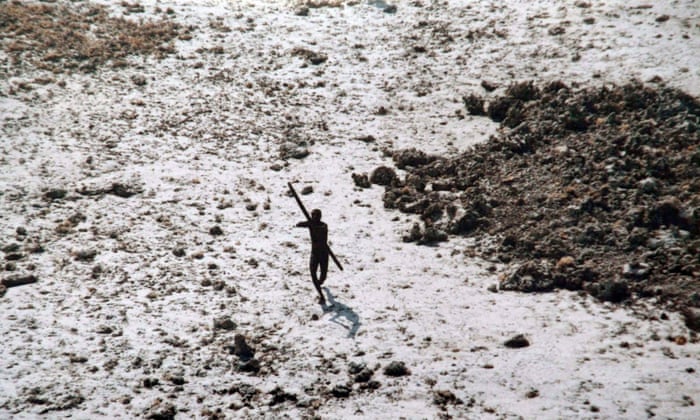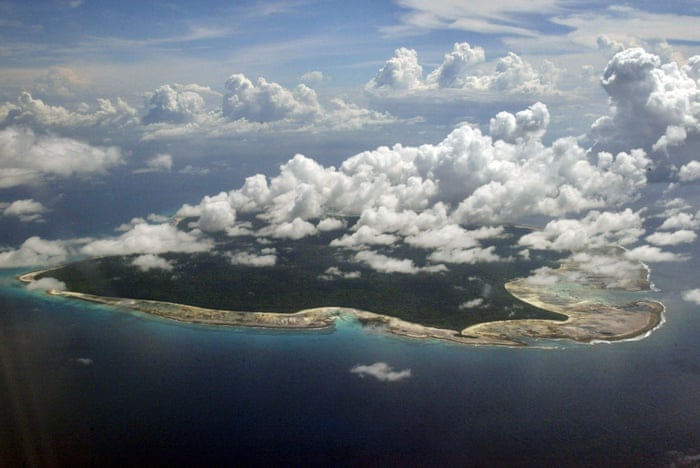Sentinel Island's 'peace-loving’ tribe had centuries of reasons to fear missionary

A tribesman aims his bow and arrow at an Indian coastguard helicopter over North Sentinel island. Photograph: AFP/Getty
 From the exiled king of Belgium to the Primrose freighter in 1981, outsiders have regretted contact with the Sentinelese – as have the islanders themselves
From the exiled king of Belgium to the Primrose freighter in 1981, outsiders have regretted contact with the Sentinelese – as have the islanders themselvesIn 1981, a freighter called the Primrose ran aground on a coral reef in the Bay of Bengal. Winds were high and the surf around the hapless vessel was heaving. The rough conditions probably saved the lives of the 28 crew aboard.
After a few days stuck in the reef, a watchman reported seeing a group emerge from the jungle on the island a few hundred metres away. The sailor’s relief at the sight of a possible rescue party ebbed as the men came into view: nearly naked, carrying spears and bows and arrows that they waved in the direction of the ship.
“Wild men, estimate more than 50, carrying various homemade weapons, are making two or three wooden boats,” the Primrose’s captain radioed to his headquarters in Hong Kong. “Worrying they will board us at sunset. All crew members’ lives not guaranteed.”
The same tribe killed American missionary John Allen Chau on 17 November. The crew of the Primrose survived. The surging swell repelled the tribespeople’s boats, while the strong winds kept blowing their arrows off the mark, according to an account by the author and historian Adam Goodheart. After three terrifying days – the crew keeping vigil with pipes, flares and other makeshift weapons – an Indian navy boat winched the stranded sailors to safety. The Primrose still lies where it ran aground 37 years ago.
Chau would have seen the ship’s wreckage as he circumnavigated North Sentinel Island the evening of 14 November, on a boat with five fishermen whom police say he paid 25,000 rupees (£275) to smuggle him there.
Like the Primrose incident, Chau’s apparent murder as he tried to preach to the Sentinelese – in breach of Indian law and advice that exposure to foreign pathogens could kill them – has fuelled fascination with one of the world’s most isolated communities. And among the most misunderstood, according to the handful of anthropologists and historians who have observed them.
Encounters between the tribe, loosely estimated to number 100 people, and the outside world are a violent catalogue. In 1974, a member of a National Geographic crew filming a documentary on the island was hit in the leg with an arrow.

Clouds hang over the North Sentinel Island, home to about 100 tribespeople. Photograph: Gautam Singh/AP
The following year, the exiled king of Belgium reportedly aborted his visit when a single, armed tribesman emerged from the jungle and waved his bow at the craft. In 2006, two men looking for flotsam on North Sentinel ran aground on the sand, and were hacked apart with axes. Police said this week their bodies were hung from bamboo poles and displayed to the ocean “like scarecrows”.
Yet those experienced with the Sentinelese reject the idea they are inherently aggressive. “They are a peace-loving people,” TN Pandit, an anthropologist who conducted one of the first successful meetings with the tribe in 1991, told an Indian news outlet this week.
“Their hostility is a sign of great insecurity,” agrees Vivek Rae, a former chief administrator of the Andaman and Nicobar islands, the Indian territory that includes the Sentinelese home.
Often characterised as a kind of irrational barbarism, their extreme suspicion of outsiders may be well-founded. “It has been passed down through generations,” Pandit says.
Centuries ago, the Andaman archipelago was a magnet for Burmese slave traders who seized members of its four hunter-gatherer tribes and sold them into slavery in south-east Asia. From 1857, the islands became a permanent British colony, a prison for those who had taken part in that year’s Indian Rebellion, the largest armed uprising against colonial rule on the subcontinent.
“The British embarked on a policy that veered between assimilation, containment and annihilation,” says Clare Anderson, a professor of history at the University of Leicester.
One practice was kidnapping members of tribes and holding them for several weeks to demonstrate the fruits of British civilisation. Maurice Vidal Portman, a commander in the Royal Navy, employed the strategy on North Sentinel Island in 1880, capturing two older tribespeople and four children he had found sheltering in an inland settlement – the only residents apparently unable to flee.
The captives “sickened rapidly”, he later wrote, “and the old man and his wife died, so the four children were sent back to their home with quantities of presents”.
The tribes who relented to British rule found themselves devastated by disease and overwhelmed by contact with alcohol, tobacco, sugar and the other vices of the settlement. In 1858, the British counted at least 5,000 tribespeople across the Andamans. By 1931, their numbers had dwindled to 460.

John Allen Chau, 26, was killed by members of an isolated tribe. Photograph: Social Media/Reuters
Even to Portman, it was obvious: “[The tribes’] association with outsiders has brought them nothing but harm,” he told the Royal Society in London, “and it is a matter of great regret to me that such a pleasant race are so rapidly becoming extinct”.
During the second world war, the Andamans were a theatre of fierce fighting and bombing campaigns. PC Joshi, a professor of anthropology at Delhi University, speculates this could have had an impact on the Sentinelese. “They must be carrying some of those memories.”
From 1967, Indian government anthropologists set out to patiently win the trust of the Sentinelese, dropping them gifts of coconuts, bananas and iron rods. The last of these would later show up in the tips of the arrows the tribe would periodically fire at the exploring scholars. They saw it as evidence that the tribe, which is at least 30,000 years old, was no relic of the neolithic era: their lifestyles could evolve like those of any other human community.
The gift-dropping expeditions have ceased in the past two decades. The Indian government’s current policy is to simply leave the Sentinelese alone. It is influenced partly by the country’s experience with another Andamans tribe, the Jarawa. In 1996, a Jarawa boy broke his leg while trying to steal fruit from a modern settlement. He was taken to hospital and spent five months recuperating. He learned a bit of Hindi and discovered television. Then he returned to his tribe.
About a year later, the boy led a group of Jarawas out of the forest in a formal peace overture from the community after centuries of hostilities. Yet the Jarawa experience is no longer regarded as a triumph. Diseases such as measles have ravaged the community. Authorities have been implicated in helping to run “human safaris” in Jarawa territory. Anthropologists fear they are heading the way of other contacted Andaman tribes.
“Think of the horrible experience of the Great Andamanese tribe,” says Kanchan Mukhopadhyay, a former officer with India’s anthropological survey who served on the islands. “They died en masse. And the Onge tribe – they don’t hunt or fish anymore. They are totally dependent on food supplied by the authorities.”
Chau’s misadventure on North Sentinel Island has sparked outrage in Indiaand reaffirmed the government’s stance. An anthropologist involved in the American’s case told the Guardian this week there were no plans to go to North Sentinel to recover his body. “They shoot arrows on any invader,” the official said. “That is their message, saying ‘don’t come on the island’, and we respect this.”

